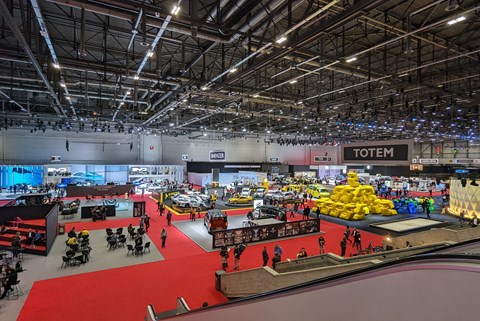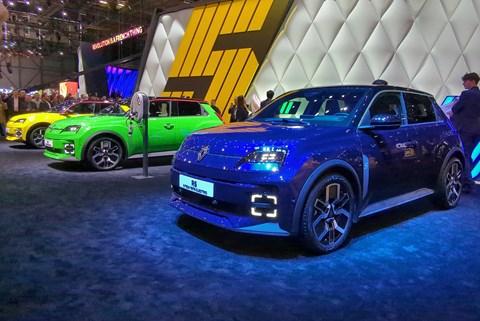► Jake returns from Geneva 2024 disappointed
► The show feels even smaller than expected
► Will it manage to continue?
For decades, the Geneva International Motor Show has been seen as one of the most prestigious car shows on the calendar, once pulling in 600,000 visitors and 10,000 of the world’s media at its peak. Before the pandemic struck, it has been arguably considered to be the place to unveil your new car.
But, even before we knew what Covid-19 was, attitudes were shifting. Changes in how we absorb news has meant much more instant content via social media, video and websites. From a car makers’ perspective, the unveil of their new car would quickly get lost in a sea of other new cars being revealed at the same time. Paying all that money to hire floor space, build show stands, arrange complicated logistics and invite the world’s media, as well as keeping all of that in place for potential future customers and car enthusiasts to see their new products was starting to lose its appeal. Particularly when car makers can sort out their own events for media and targeted ones for future buyers on their own time and their own dime.
And then the pandemic hit Europe, washing across the continent over the first few months of 2020. Organisers of the 2020 show claimed ‘force majeure’ when they decided to cancel the show at the eleventh hour as the Swiss government limited gatherings over 1000 people, with car makers likely losing millions in the process of the show being cancelled. After five years (with the previous show being in 2019), the show has returned to its homeland. That is, after an extremely odd spin-off ‘Geneva’ in Doha, Qatar in 2023. Much-needed investment talks, I suppose.
But the signs weren’t great as the 2024 show began to come into view. The full list of manufacturers, as well as the show’s floorplan, was published in January 2024. Only five major car makers confirmed attendance – Renault, Dacia, MG, Lucid and BYD – as well as a select number of start-up brands and niche automakers. To fill space, the Geneva show planners introduced curated areas designed by their own team rather than a manufacturer.
Geneva was never a large show to begin with – it was famously compact, making it easy for all visitors to navigate. But the entirety of the show’s new car reveal stands were in one hall – Hall 4, one of the smallest show halls at the Palexpo centre bar one – with a ‘classics gallery’ full of vintage and very interesting cars taking up the linked Hall 2. Geneva used to be spread across all seven of Palexpo’s halls and, on the media days of yore, there always used to be hordes of journalists at the ticket gates waiting to get in at the 7:30am opening. Not this time.

Once you’re in, the size and select amount of people attending is even more stark, to the point you could have arguably called it the ‘Renault and Friends show.’ What felt like a quarter of the floor space was held by Group Renault, with the Renault brand taking the lion’s share. And the ‘zones’ created by Geneva organisers themselves had no impact (though they likely will more during the public days).
This isn’t to discount the cars that were on show, mind you. The biggest reveal of the lot was the new Renault 5 EV – a properly interesting small car that’s had an almost glacial teaser campaign over three years. Dacia rocked up with its rough ‘n’ ready Sandrider Dakar car, revitalised Duster and baby electric Spring. BYD, keen to still get its name out across the continent, arrived with an expanded range of its EVs and even dangled the three-plus-tonne carrot that is the Yangwang U8 in front of our faces. MG’s range of cars (and its confidence) has exploded in Europe, too, while Lucid showed us the Air saloon and Gravity SUV, all the while continuing to be coy about an official European launch. And, once again, the show played host to the announcement of the 2024 European Car of the Year.

But are those new car launches enough for the car enthusiast family and interested new car buyer that will come on the public days, paying around £22 each to get inside? I wouldn’t say so, and I wonder how many will be disgruntled by the lack of stuff to see inside, as well as the lack of planned interactive demonstrations usually provided during the public days. I smell refunds.
The Geneva motor show, it seems, is on life support to the point that a show in 2025 genuinely feels wobbly. Naturally, some of this opinion comes from the place of expectation; Geneva has always been such a massive part of the automotive calendar – both for the media and the car enthusiast – that its first show post-pandemic will have had a lot of weight on its shoulders.
But the already-shifting attitudes to motor shows, as well as some of the perceived bad blood between organisers and auto makers after the debacle of the 2020 show doesn’t put it in good stead. So much so that a seemingly petulant Fiat decided to reveal some concepts with DNA links to the Panda entirely separately from Geneva, even making light of not being there by going to Italy’s own ‘Ginevra’ in a video. Bizarre.
Does this spell the end of the motor show in general? Probably not. Shows in North America are still holding, as are ones in China. And 2023’s Japan Mobility Show in Tokyo almost felt like a return to form for the classic motor show format. European ones, however, seem a little more mixed. There was arguably a general attitude of confusion and frustration regarding the 2023 IAA Mobility show’s split locations in Munich, while the 2024 Paris show in September sounds like it will be a stronger affair than Geneva.
But, after experiencing 2024’s Geneva event first-hand, the show’s organisers will need to do a lot more to make it attractive for both the media and the car enthusiast in 2025. If the 2025 show happens at all.